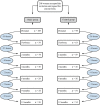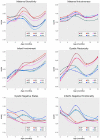The Effects of Prenatal Diagnosis on the Interaction of the Mother-Infant Dyad: A Longitudinal Study of Prenatal Care in the First Year of Life
- PMID: 35418908
- PMCID: PMC8996076
- DOI: 10.3389/fpsyg.2022.804724
The Effects of Prenatal Diagnosis on the Interaction of the Mother-Infant Dyad: A Longitudinal Study of Prenatal Care in the First Year of Life
Abstract
Introduction: Mother-child interactions during the first years of life have a significant impact on the emotional and cognitive development of the child. In this work, we study how a prenatal diagnosis of malformation may affect maternal representations and the quality of these early interactions. To this end, we conducted a longitudinal observational study of mother-child interactions from the gestational stage until the baby completed 12 months of age.
Participants and methods: We recruited 250 pregnant women from a local university hospital. Among them, 50 mother-infant dyads participated in all stages of the study. The study group consisted of 25 pregnant women with fetuses with some structural alteration and the control group consisted of 25 pregnant women with fetuses without structural anomalies. We collected obstetric and socio demographic data and pregnancy outcomes. Anxiety and depressive state data were collected using the COVI and Raskin Scales. We video-recorded the mother-infant interactions during several stages, including when the child was a newborn and when the child was 2, 4, 6, 9, and 12 months of age. The quality of the mother infant interactions were measured using the Coding Interactive Behavior (CIB). The interactive moments recorded on video was composed of three different activities, each one lasting appoximately 3 min, which included (1) Free Interaction, where the mother was instructed to interact "as usual" without any toy, (2) Toy Interaction, where the mother and baby played with a puppv, and (3) Song Interaction, where the mother and baby interacted while the mother sang the "Happy Birthday" song.
Results: In the gestational phase, there was a significant difference between the groups with respect to anxiety and depression scores, which were significantly higher for the study group. In the postnatal phase, we found significant differences between the groups with respect to CIB scales after the child completed 6 months of age: the study group presented significantly higher values of Maternal Sensitivity at 6 months of age, of Baby Involvement at 9 and 12 months of age, and of Dyadic Reciprocity at 6, 9, and 12 months of age, while the control group presented significantly higher values of Withdrawal of the Baby at 6 months of age, and of Dyadic Negative States at 6 and 9 months of age.
Conclusion: The support offered by the study favored the mother-infant bond and had a positive effect on the quality of interaction during the first year of life, despite the presence of prenatal diagnosis.
Keywords: developmental outcome; infant directed speech; langage development; mother infant dyad; mother-infant interactions; perinatal care; prenatal diagnosis.
Copyright © 2022 de Souza, Parlato-Oliveira, Anchieta, Machado and Savelon.
Conflict of interest statement
The authors declare that the research was conducted in the absence of any commercial or financial relationships that could be construed as a potential conflict of interest.
Figures


Similar articles
-
Early dyadic patterns of mother-infant interactions and outcomes of prematurity at 18 months.Pediatrics. 2006 Jul;118(1):e107-14. doi: 10.1542/peds.2005-1145. Pediatrics. 2006. PMID: 16818525
-
Prenatal ultrasound screening: false positive soft markers may alter maternal representations and mother-infant interaction.PLoS One. 2012;7(1):e30935. doi: 10.1371/journal.pone.0030935. Epub 2012 Jan 23. PLoS One. 2012. PMID: 22292077 Free PMC article.
-
The impact of prenatal serotonin reuptake inhibitor (SRI) antidepressant exposure and maternal mood on mother-infant interactions at 3 months of age.Infant Behav Dev. 2013 Dec;36(4):485-93. doi: 10.1016/j.infbeh.2013.04.001. Epub 2013 May 30. Infant Behav Dev. 2013. PMID: 23728194
-
[Mother suffering from borderline personality disorder: Which specific care in the periodal period? A literature review].Sante Ment Que. 2022 Fall;47(2):235-267. Sante Ment Que. 2022. PMID: 37279324 Review. French.
-
Postnatal Care: Routine Postnatal Care of Women and Their Babies [Internet].London: Royal College of General Practitioners (UK); 2006 Jul. London: Royal College of General Practitioners (UK); 2006 Jul. PMID: 21834192 Free Books & Documents. Review.
Cited by
-
Editorial: Prenatal and early life parent-child psychiatric interventions in the perinatal somatic context.Front Psychiatry. 2023 May 15;14:1147463. doi: 10.3389/fpsyt.2023.1147463. eCollection 2023. Front Psychiatry. 2023. PMID: 37255677 Free PMC article. No abstract available.
-
Early detection of perinatal depression in couples: a single-center prospective study.Eur Psychiatry. 2024 Sep 3;67(1):e48. doi: 10.1192/j.eurpsy.2024.1755. Eur Psychiatry. 2024. PMID: 39225230 Free PMC article.
References
-
- American Psychiatric Association (2000). Diagnostic and statistical manual of mental. Disorders, 4th Edn. Washington, DC: American Psychiatric Associantion.
-
- Ammanitti M., Tambellini R., Canderoli C., Pola M. (1999). Maternité Et Grossesse. Paris: PUF.
-
- Azevedo M. F., Vilanova L. C. P., Vieira R. M. (1995). Desenvolvimento Auditivo de Crianças Normais e de Alto Risco. São Paulo: Plexus Editora.
-
- Binda V., Figueroa-Leigh F., Olhaberry M. (2019). Prenatal and postnatal depressive symptoms: association with the quality of mother-infant interaction. Infant Behav. Dev. 57:101386. - PubMed
LinkOut - more resources
Full Text Sources

